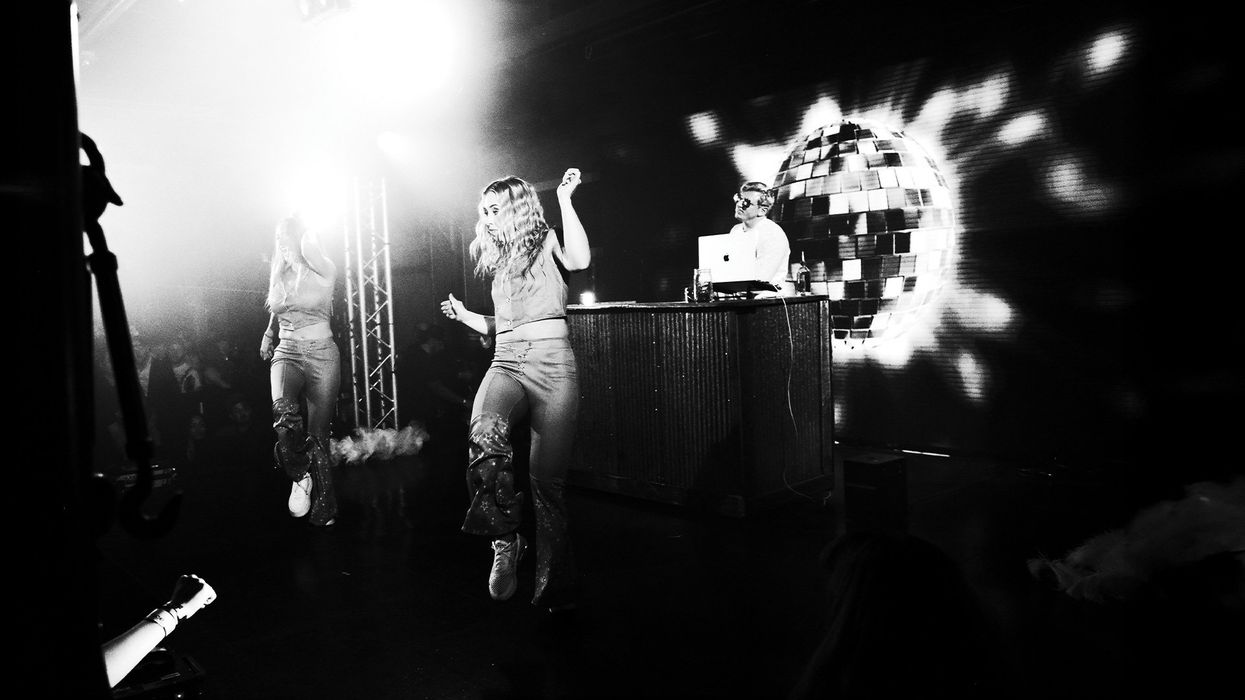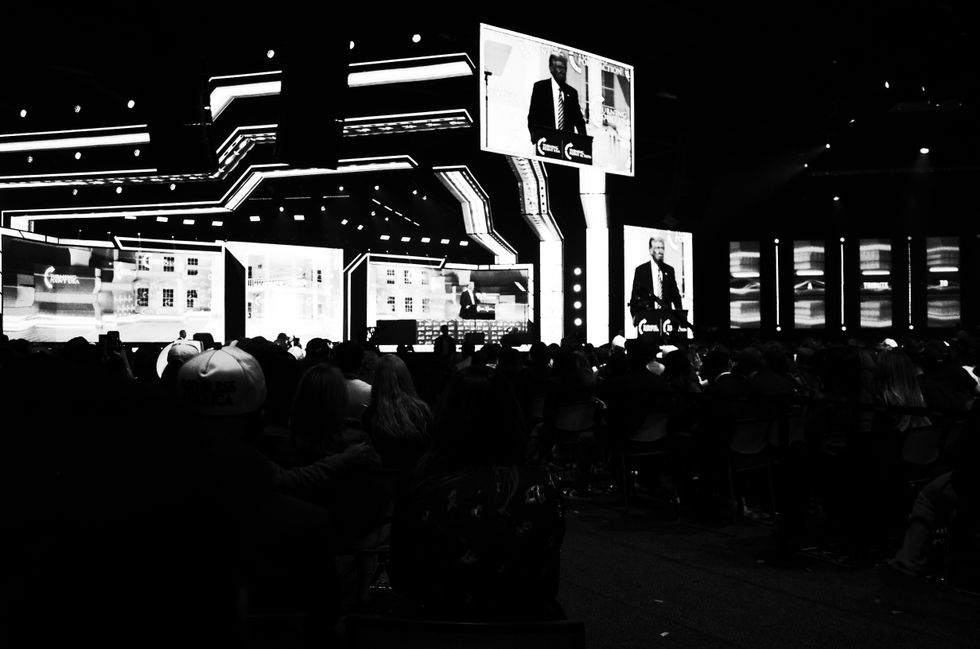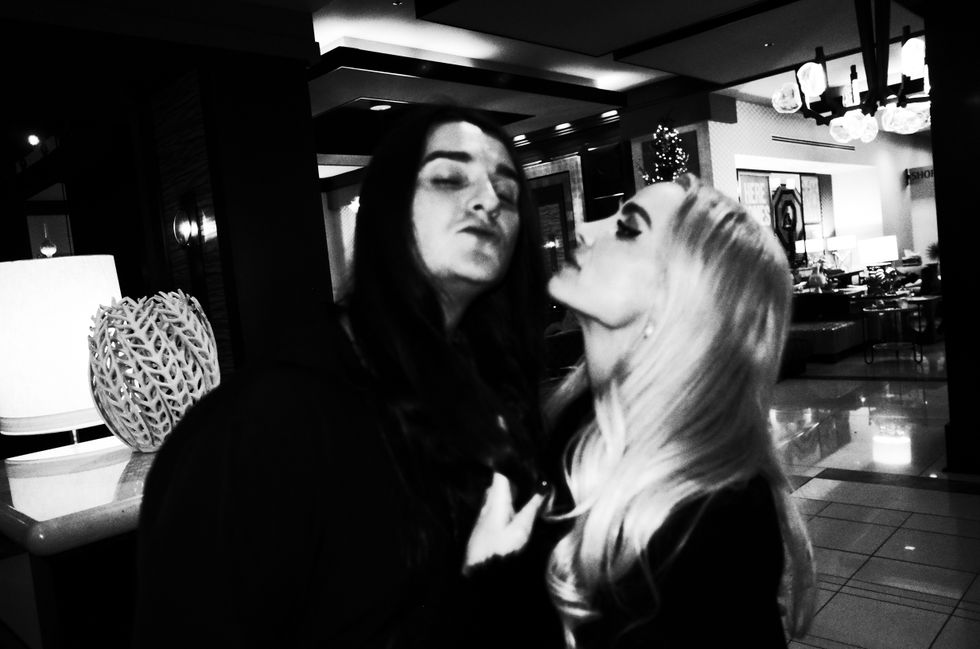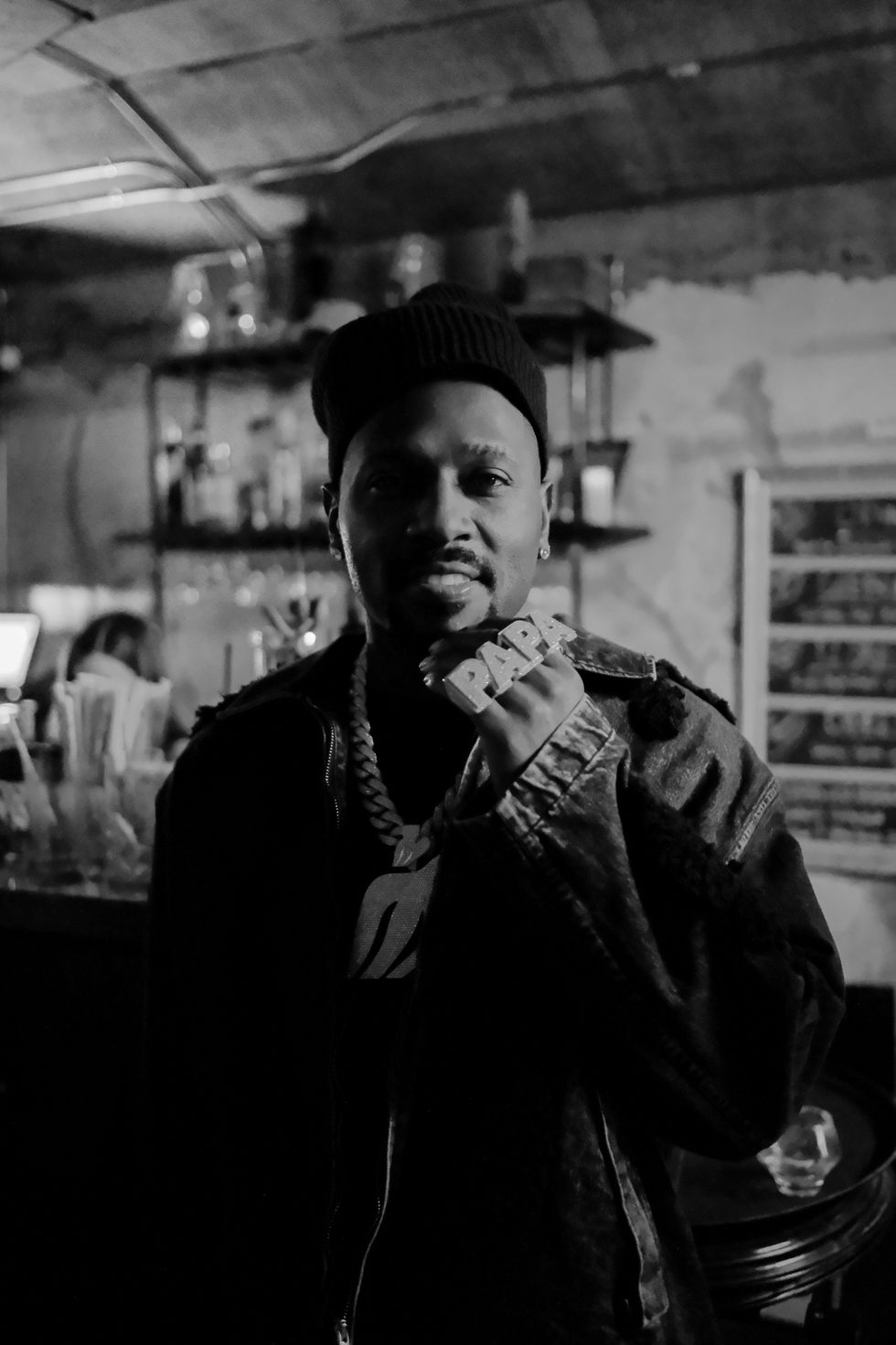
Isaac Simpson

Feature: In the sun-drenched environs of Phoenix, the MAGA movement descended on Turning Point's AmFest in the name of cultural ascendency. But what does winning look like when the consummate outsiders take power?
Eight hours and three whiskies from Midtown Manhattan, the vermillion light of the Southwest pierces the airplane window. Phoenix appears as a bowl of gleaming soup surrounded by a ring of rippling golden hour mountains, the whole city a color of glinting black-brown that I don’t think could ever be captured in crayon form.
Trump’s rising sign is Manhattan, but his moon, his emotional self, is Phoenix. Everything tan, handsome, and golf-oriented. Leisurely, sporting, business-like—but not outdoorsy, not ironic, and certainly not artsy. Like Trump, Phoenix tilts to the gaudy, losing self-awareness somewhere in the calculus of prosperity.
Anon novelist Adem Luz Rienspects picks me up in his dusty black 1997 Mustang convertible.
“Arizona is all about wasting time,” he says. “It’s about chilling and dying. But it’s also defensive. Everyone is suspicious. Everything is spiky. Hurts to touch.”
“But,” he says, “It’s the only red city.”
Phoenix didn’t actually go for Trump. It went 56%–42% for Harris. But Maricopa County, containing Phoenix, along with 62% of the population of Arizona, did shift from blue to red in 2024. Mesa, a Phoenix suburb, is the most conservative major metro, and out here, it’s just a giant parking lot without bodies of water or topographical features, so it all blends together. Phoenix, Mesa, Scottsdale, what’s the difference? Who cares?

For AmFest, the streets of downtown Phoenix ran red with MAGA. Like desert flora, the red suggests a warning. Twenty-five thousand fire ants crawling to the convention center on a jungle log. “Don’t Touch!” It’s the color of rebellion. Re-bel. Re-publican. Re-actionary. Re-d.
Communists chose red for the same reason nature and MAGA do—a conflagration, an inflammation, the redness that arises when an immune system says “no.” Blue is authority; red is the reaction to authority. Red Guards were the students who tortured and imprisoned their professors in campus buildings during the Chinese Cultural Revolution. Their Little Red Book was the guide to reacting against traditional Chinese culture.
“Fire is contagious,” says Adem, explaining the joy of being a Trumpist or a communist.
Vast convention centers—alien dreadnoughts to which attendees invariably respond, “Man, this place is huge”—are transformed into temples populated by hundreds of little shrines, all dedicated to the industry in question.
For Boomercons, the red was incidental. The media used to mix and match. In the 1990s, some stations used red for Democrats and blue for Republicans, and others vice versa.
In America, the colors switched in perfect unison with the Dems becoming the entrenched establishment as the Conservatives shifted to the “outer party” (a Curtis Yarvin phrase, meaning "the party of controlled opposition/illusory dissent").Republican leaders—still living in the fantasy that they were conserving anything—preferred blue, and the pretense of authority. It’s not that they rejected the idea of being rebels, it’s that it never occurred to them in the first place. The California GOP even officially rejected red and adopted blue as its color in 2014, although clearly the media didn’t listen. They didn’t have to.
There’s something unique about the uniformity of MAGA red. It’s not just on the hats—it’s on everything. The AmFest website contains a “look book” of outfit suggestions: “sparkles” for women and “Western fits” for men: trousers, lips, sequined shoes, festive scarves, smart blazers, cowboy boots, all tinged with MAGA red.
And it’s the exact same red. Even in the Obama years, you could never imagine liberals donning the Shepard Fairey neon sky blue with any consistency. And unlike Obama blue, it’s a deep, delicious red—a throwback, a memory. Not electric, but also not faded like a Western. It’s just pure red. Perfect for the blunt instrument that is Donald Trump.
“Yellow-based tones are typically less trustworthy. It’s why they tell you to wear blue to an interview,” says MAGA influencer/thought leader Tiffany Marie Brannon. If there’s one single human to represent Am Fest Phoenix 2025, it’s Tiffany. Precisely the type of bottle blonde, Carolina blue-eyed Fox News Barbie you dream about meeting at a Trump rally. Thirty-eight, divorced, hungry for the spotlight.
Blue may suggest authority, but red is actually older than blue. It’s humanity’s first color; the first hue used for art and deco ration, dating back 700,000 years, and the f irst named color after black and white. Tif fany explains, MAGA red is a “blue-red,” a color theory term hijacked by the makeup industry, another subject on which she is an expert.
“MAGA red isn’t about Trump,” she says. “It’s about patriotism, something as basic as truth and right and wrong. A blue red is a true red. The same as a woman is a woman. Nature’s true red is blue-toned.”
In their commitment to this particular blue-red, MAGA adherents seek more than the Elephant conservatives ever gave them—not just politics, but identity.
The color of a thing is a symbol of its culture. The rainbow flag displays a culture, as do the Stars and Stripes, as does the redness of old Communism.
“I don’t care about politics as much as I care about culture,” Charlie Kirk says during my interview with him. Almost every big speaker, practically every person I talk to—Turning Point guys, Young Republicans, anons, Groypers, YouTubers, professors, human memes, guys who drink their own piss, James Lindsay, Antonio Brown, Eric Metaxas, Scott Pressler—repeat some variation of this refrain. Culture is more important than politics.
The Left sparked a five-decade political empire in America with a “march through the institutions.” The rot of those institutions led to the rise of the hammer that destroyed them: Donald Trump.
“Conferences are sick and disgusting,” laughs Matt Peterson. Matt is the editor-in-chief of Blaze Media, the publisher of the magazine you’re currently reading. Formerly, he worked for the Claremont Institute and founded the American Mind, which has become a training ground for a new breed of right-leaning culture writer. He’s big and burly, with the furrowed brow of a classic news anchor and a childlike charisma perfect for his secondary role as host of BlazeTV.
“Boobs and business cards,” adds Tiffany.

Tiffany Marie Brannon has two and a half Master’s degrees. She’s vaguely a podcaster, Claremont fellow, C.S. Lewis scholar, and Instagram influencer. Tiffany writes about American decline and the hopeful RETVRN of a more masculine culture in the American Conservative and other such publications. She seemingly posts 700 Instagram stories per day. Her sister was Miss Arizona USA, always the prettier one, she says, while she’s the smart one, the political one, the one who will be remembered for her mind. She tells me that in DC they call her “The Lady in Red.”
Matt, Tiffany, and I are drinking Guinness at a bar the night before the conference begins. We fled the previous bar after a homeless man dragged a blanket inside. Now the homeless man has traveled across the street and set up shop right beside us. The streets of downtown Phoenix are otherwise desolate.
“It’s transactional, a commodification of yourself and who you are,” says Matt, a conference pro. “Corny weirdness and worse is par for the course, and while American political gatherings are always part carnival and grift, there is a newer, younger energy now on the right. We’re here to see if AmFest reflects that. Knowing Charlie, I already believe it does. Something real has shifted. Power has shifted. It’s here now. This is real.”
For most attendees, AmFest is a confusing hubbub of handshakes and awkward goodbyes, a whirlwind that goes by as quickly as it came. To understand AmFest, you need to understand the conference. Formerly the territory of boring tradesmen, conferences—“Cons”—have somehow become sexy; there’s one for basically every industry, and they’re open not just to business insiders but to fans of the industry, too. Fortunately, I worked in experiential marketing for two years, and attended many popular cultural conferences—Comic-Con, VidCon, ComplexCon—where I absorbed the very nature of the conference itself.
There have always been rallies, campaign stops, and national conventions for that. This is not typical political participation; this is MAGA in the shape of a Con.
Conferences are built around an industry. Vast convention centers—alien dreadnoughts to which attendees invariably respond, “Man, this place is huge”—are transformed into temples populated by hundreds of little shrines, all dedicated to the industry in question. The main thrust of the conference, the “point,” is the exhibition floor where various private proprietors involved in the specific industry inhabit pop-up booths and shill their wares. The out-of-control media circus that is Comic Con, for example, is essentially a vast outgrowth of a small collection of comic book artists who once gathered for a rather quiet interchange of ideas and work. Walking the floors of Comic Con, you can still find these diamonds in the rough among exhibits like the Experience It Live Walking Dead Zombie Walk™ and the Jolly Rancher x Mountain Dew Into the Spiderverse Dunk Tank™.
So what then, is the “industry” of AmFest? I sought the answer to this question via a four-day drunken waltz through the small-country-sized Phoenix Convention Center. Attendees like Tiffany, who let me draft off her VIP status for the duration, provide a clue. The answer is not simply “right-wing politics” or “Donald Trump.” There have always been rallies, campaign stops, and national conventions for that. This is not typical political participation; this is MAGA in the shape of a Con.
AmFest begins on the ground floor of the gargantuan Phoenix Convention Center, then spirals four or five stories downward, a cavernous termite’s nest of red-capped humans, every inch wallpapered with MAGA brand slogans, always in red or blue—or, like TPUSA itself, a neon spectrum from red to blue that appears purple. This, the escalation from red to purple, seems to be the perfect metaphor for a critic elevated to governor—for example, the right after Trump’s landslide victory.

What is AmFest? Coming down the escalator, I get a semi-bird’s eye view of the layout of AmFest and have an aha moment. It’s hard to tell on the floor, but from above, you can see it. It’s a hundred mini broadcasting studios. Each chamber of the termite’s nest has its own talking head shouting into the void. It’s an overwhelming proliferation of pop up TV news studios—shrunken desks sur rounded by forests of key lights and cords.
In the first chamber of the cavern are all the alpha dogs: Daily Wire, Blaze Media, Real America’s Voice, the Larry Elder Show. Then, the smaller efforts, media startups with names like Trigger Finger and the Firing Squad, others no more than hopeful one-man podcast operations, all with red, white, and blue sets, set up and struck in a week like Burning Man camps. These entrants are the OG Comic Book artists of AmFest, the core nucleus holding it all together. They’re sur rounded by various brand pop-ups, the veritable “culture” of the conference, which includes based coffee companies, infomercial grade exercise machines, Magachristmasbooks.com, Masculine Man aluminum-free deodorant, and a Charlie Kirk-branded hot sauce: “Good on Everything.”
The smaller soapboxes surround the central bully pulpit, which hosts speeches from right-wing mega-celebrities—Tucker Carlson, Ben Shapiro, Steve Bannon, Glenn Beck, Matt Gaetz, Tim Pool, Patrick Bet-David—in a neon Thunderdome, flooded with the purple at the turning point between red and blue.
It all amounts to a vast hierarchy of free speech and its exercise, but in the poppiest, most cable-news-ish meaning of the word. The Founding Fathers worried about too little free speech, but did they ever consider the possibility of too much?
Infamous anon Peter Nimitz, in attendance, tweets: “After seven hours at this conference, I have yet to hear how I, or anyone else here, can participate in the political system at a level beyond consuming media.” He has a point. The air of America is toxic: percolating waves of fear wafting toward the brains of our Boomer parents. Like their liberal counterparts, the right yearns, absolutely craves, to partake in the idiot wind. AmFest might as well be a broadcasting competition. For so long, conservative culture was defined by complaint.
Clearly, it’s not all hot air if it got Trump elected. But a whole lot of it is.
I seek the protection of the Blaze tent and watch Matt Peterson finish up a broad cast with his co-host Jill Savage. Afterward, he steps out of the mini-studio and is immediately accosted by a plucky Political Strategist | #1 Best-Selling Author | Speaker | Prosperity 101 Podcast Host | Executive Coach | Business & Marketing Consultant Hadoukening brochures and business cards with unbearable earnest ness. She’s got expensive hair and even more expensive veneers, like chunks of classroom chalk, and an unhinged passion for reforming culture. She sinks her hooks into Peterson and won’t let go.
“We must reclaim the mountains of culture!” she explains. Her organization is a vague education project aimed at business es. “I really feel like God told me to do this.”
This is the dance of the thing: less important people behind the camera throw themselves at more important people in front of the camera, while the more important people challenge themselves to seem interested. The better you are at this, the more important you get.
There’s rarely a clear ask, though. Usu ally, it’s more like “Here’s my card” and a follow-up with emails that surely go unreturned. There is something erotic about it— “These things are always weirdly pervy,” says Tiffany—a reverse sexual marketplace, where aging women attempt to force themselves in front of the recording devices if only they can connect with the people already in front of them.
I drift over to another area, where a crowd has gathered around a man in a business suit emblazoned with orange bricks. An Asian family stops him to snap selfies. A handsome Jewish man in his 60s with Bernie Madoff vibes—you could see him in finance or medicine—but here he is wearing a costume that looks like it’s from Spirit Halloween. This is “Brick Man.” I ask him how he became a human meme.
“I bought this suit on Amazon because I wanted to troll the libs,” he says. He seems a little sad, maybe a little embarrassed. Or just bored. “I’d gone to a ton of rallies. I went to one with my dad”—he’s referring to a rally in Pennsylvania in 2019—“where I was holding a sign that said ‘Build Me.’ And then Trump called me up on stage. It was surreal.”
Then walks up a guy with a long gray beard and brown and gold designer sunglasses. He’s tanned, toned, and in immaculate shape, with the face of an actor, a race car driver, or maybe an ex-military sniper. Someone whispers in my ear “This guy drinks his own piss.”
“I drink it every morning,” he says. “It’s the only substance on earth that has your own stem cells in it. It took me a while to learn to ferment it. I used to just drink it straight. Anyway, you can learn more at urinetherapy.com.”
This is Certified Health Nut, one of the first silver-fox health influencers in the vein of Liver King or Paul Saladino (who is also here), dating back to the early 2000s. He used to be a Versace model, then got sober after an ayahuasca experience in the Amazon jungle. He got into esoteric remedies and was one of the first to start making YouTube videos about them. He shills a book called Ripped at 50 and says that he’s apolitical; he just doesn’t like the woke stuff. Like the Hadouken woman, he’s fixated on media opportunities. He wants to get in front of the lights. Later he texts me to follow up, asking if I might be able to spare a media opportunity or two. Yes, Certified Health Nut, here you go.
Of course, in America, political gatherings have always been like this: part corny-carnival, part grifting-sales, part speechifying…sometimes even involving iconic headgear. Davy Crockett, of coonskin cap fame, once noticed that his opponent at a dueling political rally was giving away drinks to draw a bigger crowd. Davy, short on money, but in possession of plenty of animal pelts, began slapping down pelt after pelt on the bar in exchange for free rounds to the masses. It worked, and he served in Congress for eight years. American politics have always been a circus act of some variety or other, the real question is what, if anything, is different about this time.
“Remember the Obama years?” a high-ranking Kirk lieutenant who doesn’t want to be named asks me in the VIP section. The press isn’t allowed in the VIP section, but Tiffany snuck me in. It’s very dark, besides blue and red neon lights that, once again, combine to blacklight violet, like the inside of a haunted house. I’m drinking free Sea gram’s whiskey sodas and eating free gyros off a toddler-sized plate. It smells like Middle Eastern food and smoke machines. “Obama was the absolute king of culture. They con verted a bunch of young kids and made all the girls want to date you. If you’re not into Obama, forget it. It was culturally desirable.”
The lieutenant is young and handsome, tan scruff on a teacup jaw and a form-fitting suit. He’s buzzing around the VIP section, pollinating conversations. He describes Charlie’s early days—the very beginning, when Charlie went to college campuses with nothing more than a card table and a printed sign, reading “Big Government Sucks.” Paradoxical because Charlie never went to college himself, yet he’s the biggest on-campus converter, pulling students out of Obama’s grip.
“Charlie’s naturally intelligent,” he says. “And he wields it. Charlie is a doer. He does his show while texting and looking at all the screens at once.” He tells a story I hear several times about Charlie raising $17 million in 45 minutes.
Charlie’s people are capable, good-looking, and smart, but they yearn for a coolness that’s always just out of reach, in that mythical wonderland we call culture.
MAGA is a blunt instrument—the simplistic slogan, the inch-thick makeup, the sequins, that brazen, unsubtle red—adopted by blunt people, kulaks, those who use Canva to make Facebook advertisements for their jet ski rental operations, and who genuinely either don’t care or don’t understand the first thing about being culturally cool.
On the other hand, Trumpists check every box that the people who supposedly are cool yearn for: digital natives, grassroots commoners, folksy songs, profound symbolism, genuine joy, deep insight conveyed with a plainness of speaking, and the overthrow of censorial overlords via the pure down-to-earth power of the collective.
Politics is a set of peacock plumes. Each plume is an issue, and the eye of each plume is a talking point, each specific color is a different phrase: “Make America Great Again” or “build the wall” or “Sleepy Joe.” If you can make the peacock’s tail move in graceful unison, you win. The Dems used to do it with data, surveys, and hollow language about hope and togetherness. Updating issues by memeifying them is what makes Trump extraordinary. How many Make ____ Great Agains have you seen in the past couple of years? His kulak-friendly simplicity has taken hold everywhere.
The Dems lost, in large part, because they stopped being able to communicate their issues in cool, meme-y ways. “I’ve never seen a worse mistake from the Democrat human centipede than calling JD Vance weird,” says Ben Shapiro, during his speech on the big purple stage, criticizing the incompetence of the Harris-is-Brat campaign.
The stage entrances are straight out of the WWE, impressive productions with original videos, soaring eagles, spraying fireworks, and trap music thumping like a nightclub. They’re lowbrow, but genuinely exciting, genuinely cool, one of the many details that Charlie and his team get right.
Steve Bannon, fresh out of prison and sporting his trademark Barbour jacket, is satisfyingly pugilistic.
“We don’t need partisanship. We need hyper-partisanship,” Bannon says. “I’ve been trying to think about what happened, and what really happened is that the spell was shattered. A spell is something that, if repeated enough, gains power. The way to break a spell is to say ‘boo’ really loudly. Then everyone wakes up.”
Tucker Carlson tells a story about his friend’s mom, a divorced, angry feminist, smoking cigarettes by the pool and bad mouthing the entire race of men. “That was 1970,” he says. “Then I woke up 30 years later and realized the whole world had become her.”

After the days buzzing around the hive of broadcasters, the nights are full of private parties. As is typical of all conferences, get ting into them requires a soul-destroying dance of invitations, wristbands, and status levels. At AmFest, the night parties—host ed by Daily Wire, Blaze Media, and other recognizable media brand names—are held in sleek, beautiful event spaces that smell like flowers and Old Fashioneds (to say nothing else about downtown Phoenix, the interiors are gorgeous), and feel authentically fun and relaxed. The important crowd letting their hair down and having the conversations they really want to have without being pestered by the masses.
At one such party, former NFL star wide receiver Antonio Brown enlightens me on the culture problem. Brown is known for stripping off his shirt and running off the field after a dispute with a coach who “treated him like a dog.” Since then, he’s become a right-wing X influencer known for criticizing woke publicity moves and cowardly media figures, the latter of whom he dubs “faggots of the day.” He shows up at an afterparty with one of the most beautiful light-skinned black women I’ve ever seen.
He reeks of weed, but I manage to ask him one question: why is the NFL so woke?
“Because people wanna have a louder voice,” he says, swaying, red-eyed, his attention threatening to fall on literally anything else besides the guy asking him annoying questions. At first, I thought he was saying something positive about the NFL and that maybe I, and everyone else, completely misunderstood his positions. But then he clarifies, “They wanna be more than just a player. If you’re just a player, you have no future.”
NFL players adopt regime politics because they need regime paychecks after they retire. And the way to do that is to “express yourself” on air. This is what drives complicity: the charade of players “speaking up.” And here is the “culture” we hear so much about.
One night, there’s a rave hosted by James O’Keefe. It’s a bit early for a rave. James appears on stage as DJ with several female dancers and one male dancer in a cowboy hat. The group of them DJs and dances, with O’Keefe himself showing off some highly choreographed dance moves and at least five highly coordinated wardrobe changes. The music is good, and a large crowd sings and dances along, but it all feels, or smells, like a bar mitzvah—a stench that seems to follow all politics wherever it goes.
At the rave, Tiffany introduces me to Scott Pressler. Pressler is one of the more buzzed-about DIY activists in the MAGA movement. Everyone says the same thing: “I would do anything for Scott, he won us Pennsylvania.” And indeed, his tenacity and commitment in the ground game delivered incredible results in Pennsylvania.
I ran into him the next night around 2 a.m. in the lobby bar of the Hyatt, a beautifully done, Tulum-like interior, where the late-night crowd gathers. Scott is tall and thick with long, brown hair, and I wouldn’t say flamboyantly gay, but very obviously so, with a finger-snappy manner of speaking. He tells me that conquering Pennsylvania was far more straightforward than you’d expect; all it took was remaining singularly focused on registering every potential Trump voter that could possibly be registered—an arduous, annoying task, but one that the professional losers in the GOP never managed to get around to.
“My goal is being a cheerleader. Motivating and identifying the grassroots, training volunteers. I focused on the most important thing, which was voter registration. In 2020, the Democrats had 700,000 more registered Democrats than Republicans. Today, four years later, that number is down to 286,000. If you take out active voters, that number is 126,000,” He talks in rapid-fire succession, mowing down political peacock feathers with a wood chipper. “We’re on our way to making Pennsylvania the next Ohio, and so we visited fraternity houses and gun shops and VFWs and farmer’s markets and Home Depots and Bass Pro Shops. We engaged where we knew conservatives would be. We got them registered. We mobilized them. We got them out to vote. And we won.”
He’s interrupted by two girls in sequined Trump cowboy hats who ask to take a picture, whom he’s happy to indulge. He’s laser-focused on a handsome, besuited man holding court near the bar. He turns to Tiffany and whispers, “If I’m glowing, it’s because I’m pregnant . . . from last night.” At AmFest, like everywhere else, power is an aphrodisiac.
Finally, it’s time for my turn in the spotlight. I crawl over to the convention center for an 11:30 interview with Charlie Kirk at the Blaze booth. Between Manhattan and Phoenix, it’s been a week of “work,” which is to say, social drinking. Still, my body has somehow held up, my biles are balanced, and I have good energy and clarity. Despite my tongue being coated with tortilla chip turpentine down into my esophagus and a fluttering pain around the eyes, I feel fine and exhilarated to be interviewing Charlie Kirk, the belle of the whole friggin’ ball.

I’m shuffled into the Blaze Media booth to wait for Charlie. The electron crowd gathers around us, and I try to ignore it as I spend the next twenty minutes trying and failing to get Charlie and his handler to give me some juicy personal nuggets. Another ironic thing about Charlie: he’s known for being the shepherd of the fiery youth, but he’s so well-media trained that, in many ways, he represents the most mature and traditionally “political” part of the whole MAGA movement.
“Do you remember your first campus card table debate? What was that day like?” I ask.
“No, I don’t. I mean, the genre was growing. Crowder was doing similar stuff, and I thought it was smart,” says Charlie.
“Did you have visions of becoming this sort of leader?”
“No. Not really. I’m a one-step-at-a-time sort of guy.”
“Do you remember your first moment of political consciousness?”
“I’d have to think about that. I’ve always cared about the country. I’ve always cared about politics. I don’t know how to answer it…. Sorry. I just did two hours of brain-dead interviews.”
Like most big names, Charlie glows with an impossible tallness and tanness, lines cleaner than they have any right to be, built for TV. I’ve found that there are two kinds of celebrities: normal people projecting weirdness and weirdos projecting normal ness. Political celebrities are particularly enigmatic because they’re supposed to be able to pass the “beer” test—as in, you’d like to have a beer with them.
Drinkers like Elizabeth Warren, Kamala Harris, and Hillary Clinton notoriously fail this test, while non-drinkers like George Bush and Donald Trump pass it. They’re supposed to be typical ol’ shoot the-shit type of guys, but they’re also supposed to glow, and glowing requires sociopathic commitment to appearances and career objectives and also just a natural, unlearnable theater kid specialness that emanates from within.
So in politics, you get normal people projecting weirdness projecting normal ness. Charlie struck me as precisely this type: a regular guy swept into greatness by immeasurable passion and a genuine glimmer who has a pretty easy time passing the beer test because, at the end of the day, he’s comfortable being normal. Hanging out with him, even briefly, reminded me of being around LA commercial real estate bros or oil guys in Texas—the kind of dudes you want to drink 17 spicy margaritas and quote Old School til 6 a.m. with. The beer test on steroids.
But that doesn’t mean he’s not a game player, and in this game, he was not going to reveal any unpolished corners. He spends most of our interview expertly hitting the talking points, and refusing to stray from the pre-approved points. That is, until we get to the culture conversation. Here, he perks up, “Again, I’m actually more interested in the cultural stuff than the political stuff,” he says.
He raises Hillsdale as a rare example of right-wing culture done right. How it’s managed not to get destroyed by managerial elites—for example, like Angel Studios, which got bullied into making girlboss movies the instant it became popular after Sound of Freedom.
According to Charlie, Hillsdale succeeded because of strong, singular leadership, and commitment to goodness over greatness.
“At Hillsdale, they’re leading forth toward the ultimate virtues. Courage, prudence, the good man is what they do at Hillsdale… and Larry Arnn, I mean, he rules with an iron fist. I could do a whole hour on him. The reason he can do it is because he himself is a professor, and you can’t take command of an institution if you can’t play ball with the faculty.”
The answer to what Charlie means by culture is deceptively simple. He doesn’t mean music. He doesn’t mean memes. He doesn’t mean hot girls. He means the institutions, like the universities, that the political right hasn’t been able to penetrate in a century. They could only throw stones.
And what of Charlie? Who is he in his heart of hearts? Stone thrower or university president?
“I want to have the influence on my pod cast that Rush once had. Not to be Rush, but have the influence. I think that’s missing where someone does a straight-to segment and it’s talked about everywhere. Tucker was the closest thing to Rush. And he still is, but it’s different. But if Tucker did a monologue on you on Fox News, your career was over. If Rush did 20 minutes on you, it’s over. I would love to one day graduate to that level.”
I’ve graduated thrice: from high school, college, and law school. In each case, I’ve moved away afterwards. Dark feelings of impending doom. A loss of innocence. Always a tepid goodbye to the friends I’m abandoning. Always a confusing change of state requiring huge amounts of RAM to process. And, as an only child from a bro ken family, always an awful opportunity to judge myself by what others have: loving nuclears laughing wistfully while I sit in the corner in a resentful rage.
Red is rebellion. Red is the first color because you can’t detect the authority without the rebel. This is why red is sexy and noticeable.
So perhaps I am more attuned to the ends of things than others.
The falseness of the word “conservative” to describe the American right is revealed in red; it was never the authority. It was always the rebel force, there to inflame and complain when the authority (blue) went too far. My president is black, my Lambo’s blue. Obama is blue. The UN is blue. In Pharma, there’s a trope that every brand is a calming, authoritative “medical blue.” Goldman Sachs and JP Morgan Chase are blue. A leviathan of institutions—perhaps a culture—moving ever-leftward with occasional disruptions from the whining reds.
Red is rebellion. A fleeting exhortation. It’s the beetle juice that warns the enemy—the protective coating on a cactus fruit that keeps out the frost. Red is the first color because you can’t detect the authority without the rebel. This is why red is sexy and noticeable. And it’s why neoliberals, for all their talk about being yourself, don’t actually want to stand out. They don’t want anybody to.

There’s not much I can say with certainty about the MAGA movement after four days at AmFest other than this: it’s the end of an era. The MAGA movement has officially graduated from rebellious high school student to full-fledged adult. Glowing purple, the transition from the red of youthful rebellion to the blue of mature authority.
Unlike with my own graduations, the sense of finality I felt at AmFest was wistful, happy, and triumphant. We won, after all, and every bit of that victory was earned. Watching Trump’s speech from the journalists’ black box, knowing that half of them were seething with rage, really did feel great. Genuinely inspiring in the deepest sense. Roller-coaster-drop elation.
I see Trump’s victory as a referendum on wokeness. I listened carefully to which policy points in his AmFest speech received the biggest cheers.
First place: “We’ll stop this trans insanity.”
Second: “Woke is bullshit.”
These culture war issues were the spark that made it all possible.
But the culture war is over. We won, at least on paper. So what do the warriors do? Where do we go from here?
Good activists rarely make good governors. Many on the right have adopted the tactics of Saul Alinsky, the bright red 1960s left-wing activist who trained the entire Obama wing of the Democratic party— and perhaps these tactics allowed us to win. Undoubtedly, our blue overlords are rotten, and red victory was both essential and inevitable.
But building a culture requires not just rebellion; it requires authority. Not just polemics but principles. The left rotted because it failed to leave Alinksy behind. It couldn’t stop winning long enough to govern. The Right must learn from this, or it will face the same fate, and much more quickly because it lacks institutions. To avoid being immediately hollowed out, the institutions we do have must be designed not just to win but to make great works and good men. This is what it means to become the governing authority, at least a lasting one. We should focus now on Making America Great Again, yes, but also on Making America Good Again.
Nobody understands politics versus culture better than Tucker Carlson, the number one talking head. Charlie marks him as the top of the heap . . . that is, until he was booted from the institutions.
“When you’ve thought you lost, it’s where you sometimes are winning,” said Tucker on the stage, referring to the oncoming collapse of woke institutions. “Same thing. When you think you’ve won, you’re in for a surprise.”
Isaac Simpson